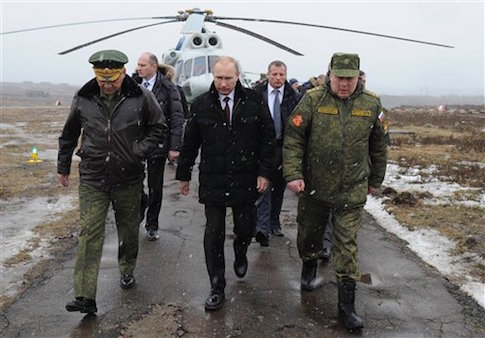Putin’s Russia has revived its once flagging global arms sales business and is using those sales to revive its defense industrial base. Second to only the United States with about a 26 percent share of the global arms market—the United States has a 30 percent share—Russian arms sales in 2013 generated some 13 billion dollars for government coffers according to the pro-government Russia Today.
Other sources, such as the Stockholm International Peace Research Institute (SIPRI), claim that the annual value of Russian arms sales, which the Russian government cloaks in secrecy, often exceeds that of the United States.
The obvious financial benefits tell but a small part of the value Russia derives from its arms sales abroad. Unlike the United States where large private corporations such as Lockheed and Raytheon compete for arms contracts, since 2007 Russia has relied on the state-controlled consortium Rosoboronexport to monopolize Russian arms sales and to advance Russian foreign policy objectives.
For example, ties with China and India, Russia’s largest customers, are enhanced through the arms sales network. It is in Russia’s arms sales to Syria and Iran, however, that Russia most effectively uses its arms sales clout to advance the Kremlin’s strategic interests.
Syria is Russia’s sole remaining Arab ally. Russia’s lease of the Syrian port of Tartus provides the Russian navy its sole access to the Mediterranean Sea. Through three years of civil war that have left over 200,000 civilians dead, Putin has sided with Syrian President Bashar al-Assad’s efforts to suppress those seeking his regime’s overthrow. Over the course of several decades of support it has provided Syria with over $4 billion in military equipment, according to Jeffrey Mankoff, an adjunct fellow at the Center for Strategic and International Studies.
The Kremlin is worried that the Sunni revolt against Assad’s brutality could spill into neighboring southern Russia where for decades the Russian military has fought separatist Chechen rebels.
For Syria, the arms trade is equally important. The sales volume is far down the list of Moscow’s largest transactions but account for nearly 80 percent of all Syrian arms purchases.
Recent sales also have been carefully calibrated to provide Assad’s forces equipment for countering the Sunni insurgency. Russian sales to Syria of T-72 battle tanks, interceptor aircraft such as the very fast Mig-31, training aircraft and attack helicopters are playing a pivotal role in inflicting heavy casualties on insurgent forces. Sales of air defense equipment deter the use of air power against the regime.
Russian military assistance to Iran’s theocratic regime focuses on the Iranian need for a robust missile force capable of attacking distant land targets and ships operating in and around the Persian Gulf.
Since at least the 1990s Russia has been providing technical assistance to Iran’s development of a long-range missile program, as described in riveting detail by New York Times correspondent David Sanger in his 2012 book Confront and Conceal. Russian experts have assisted Iranian counterparts in such critical areas as propulsion, navigation and engine development.
Today Iranian missiles can hit targets throughout the Middle East, and Iran is assessed to be developing even longer range missiles, claiming that its objective is to launch communications satellites.
In addition to ground-to-ground and ground-to-sea missiles, for years Iran has sought Russia’s S-300, an advanced air defense system that could degrade an Israeli attack against Iranian nuclear facilities. Intense international pressure has restrained those sales in the past. The continuing deterioration of Russia’s relations with the West may make a deal more likely but Iran also is looking to produce its own variant of the S-300, according to the Jerusalem Post.
Unconfirmed reports have circulated for years that Iran was paying Russia for at least some of the equipment being sent to Syria. In turn, Syria has received various "finder fees" from Iran for sending to Tehran air defense equipment acquired from Russia.
Russia’s arms sales program is fraught with rampant corruption, inefficiency, and outmoded equipment. Nonetheless, military sales and assistance to Middle East customers have evolved into a critical element of Russian foreign policy and major asset for the Syrian and Iranian militaries.
